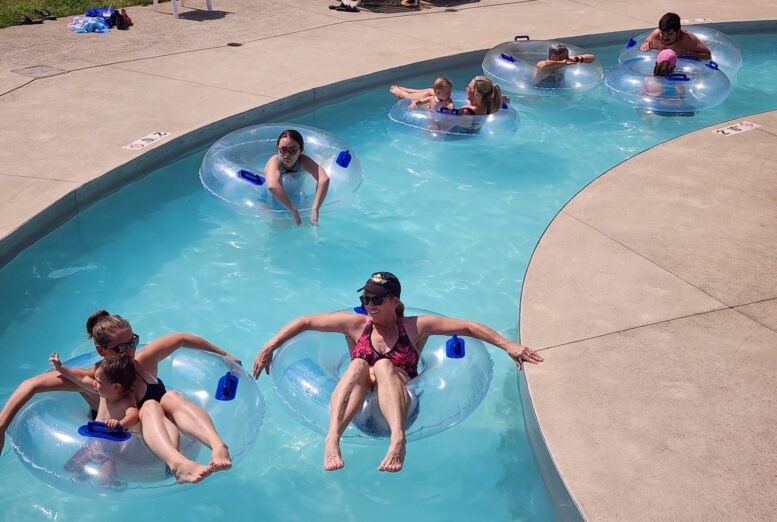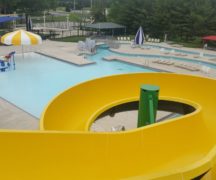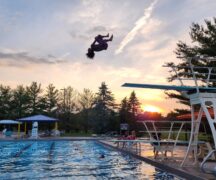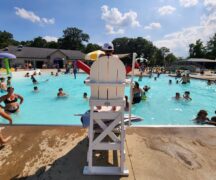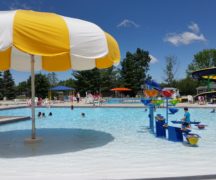By JAN LARSON McLAUGHLIN
BG Independent News
Community pools often become a second home for kids during the summer. It’s there that youngsters learn how to play “motorboat” and years later perfect their butterfly stroke. It’s there that families can escape as they beat the heat and blow off energy.
On steamy days, the Bowling Green City Pool packs in patrons from nearly sunrise to sundown. It’s a refuge from sweltering temperatures – and for some families, it’s their home away from home in the summer.
Days like last Wednesday make the pool even more popular as patrons flock to the facility. The day started hot, finished hot, and peaked midday in the mid-90s. Here’s a snapshot of that particular sunny day at the pool.
Bubbles to backstrokes
Weekday mornings at the pool are busy with young swimmers learning that getting their faces wet is survivable, and older students mastering their backstrokes or butterfly techniques.
Over by the “lazy river” are the 1-2-year-olds buoyed by their parents, who encourage their children to get comfortable in the water. They bounce in their parents’ arms and are propelled across the water with adoring coos of praise for their “accomplishments.”
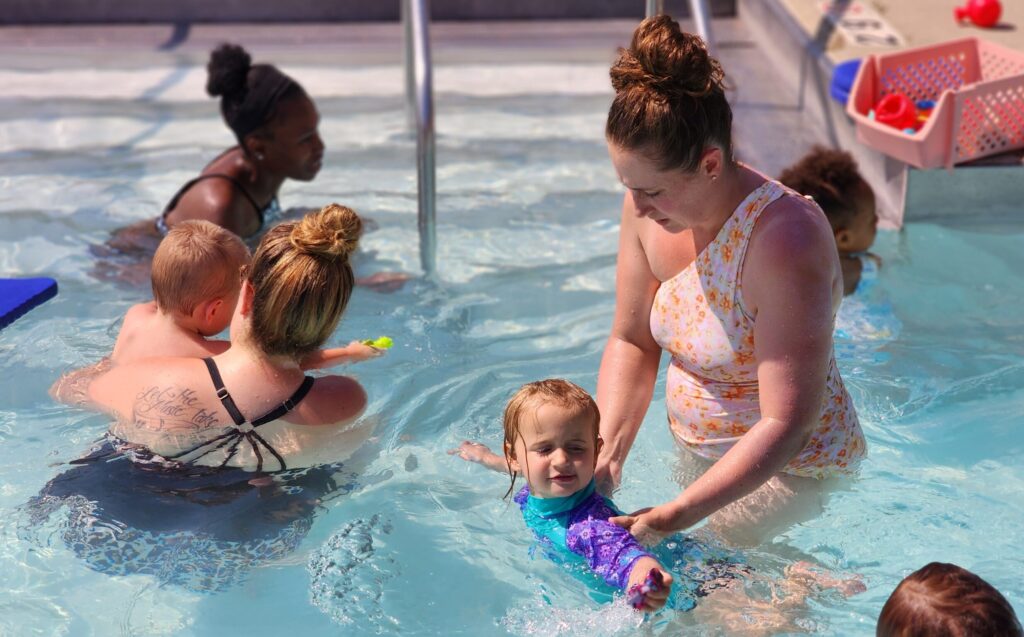
In the shallow section of the pool are Level 1 lessons, where youngsters learn to blow bubbles in the water, completely submerge themselves, work on their front and back floats, learn to “blast off” from the side of the pool, and jump into the water themselves.
The lessons focus on fun, so the learning happens naturally as the budding swimmers play games like the treasure hunt that gets them to go underwater, and motorboat that encourages them to blow bubbles.
Some students come to class already as fishes, while others approach the lessons with great trepidation. So the instructors work to make them all comfortable in the pool.
“We had a couple kids who wouldn’t get in the water at all – and now they are in,” a Level 1 instructor said in between classes.
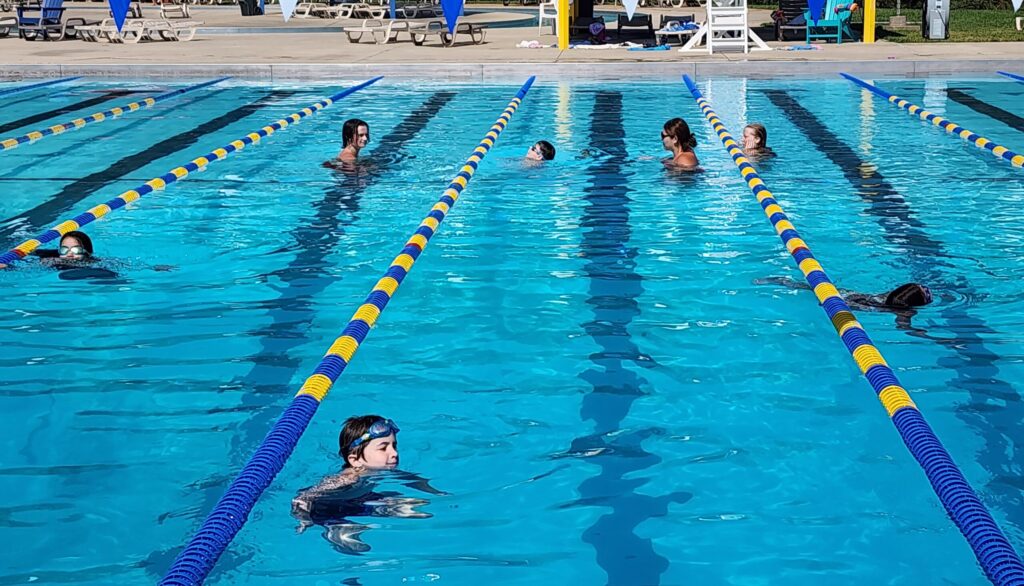
With each advancement, the students gain more skills, progressing to learning strokes, then perfecting them and performing them for longer durations.
At the younger levels, the skills taught are limited, but the patience required by instructors is great. On Wednesday, a Level 1 instructor started the class by engaging the students.
“It’s a perfect day to jump in,” she said, then asked each student and instructor to list their favorite TV show. She started out with her favorite, “Dora the Explorer,” which was undoubtedly a choice made for her young audience. Hands shot into the air, with children listing off “Pup Patrol,” “Peppa Pig” and “Snow White.”
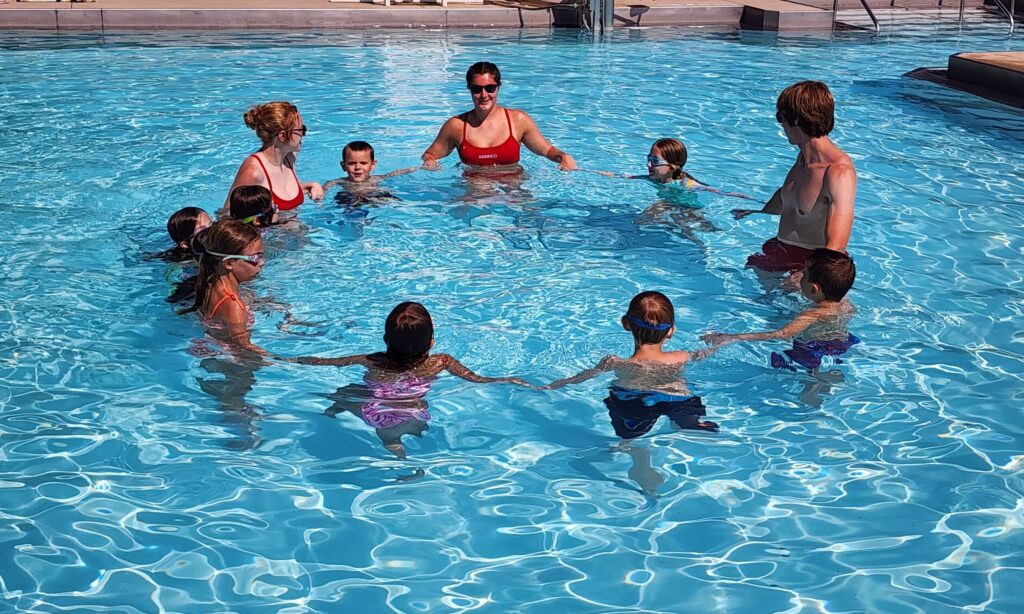
But as the young minds wandered, children piped up with other news they wanted to share with their instructors. “I have a mosquito bite on my leg,” one boy said. “I rode a horse before,” a girl stated proudly. Another girl asked if the swim instructors liked the ruffle on her swimsuit, another showed off the temporary tattoo on her hand. The children started listing off how many friends they have. “I have three friends,” one boy said, then reconsidered. “But my mom’s a grown up.”
As children headed for their towels when classes ended, several were willing to discuss their progress, knowing that the next day they would be tested to see if they would pass to the next level. And following that, on Friday, was the promise of the traditional “fun day” to celebrate the completion of their courses – pass or fail.
Colton Tyda, 6, was feeling good about his backstroke, front glide and back glide. However, the alligator roll – moving between front and back floats – was a bit tricky. But Colton was working hard on it, practicing it “a million times,” he said.

Also in Level 2, Camden Dosch, 11, was feeling pretty confident that he would pass testing.
“I like my teachers, they really help me learn swimming techniques,” Camden said.
His younger brother, Mason, 8, said the toughest skill for him is the backstroke. “It’s hard to keep your arm straight,” he said.
And the youngest brother, Brayden, 4, bragged about being able to blow bubbles and go underwater after two weeks at Level 1 classes.
At Level 4, Arden St. John, 12, was feeling strong about his front crawl, backstroke, elementary backstroke, sidestroke and breaststroke.
“I feel pretty prepared” for testing, he said.
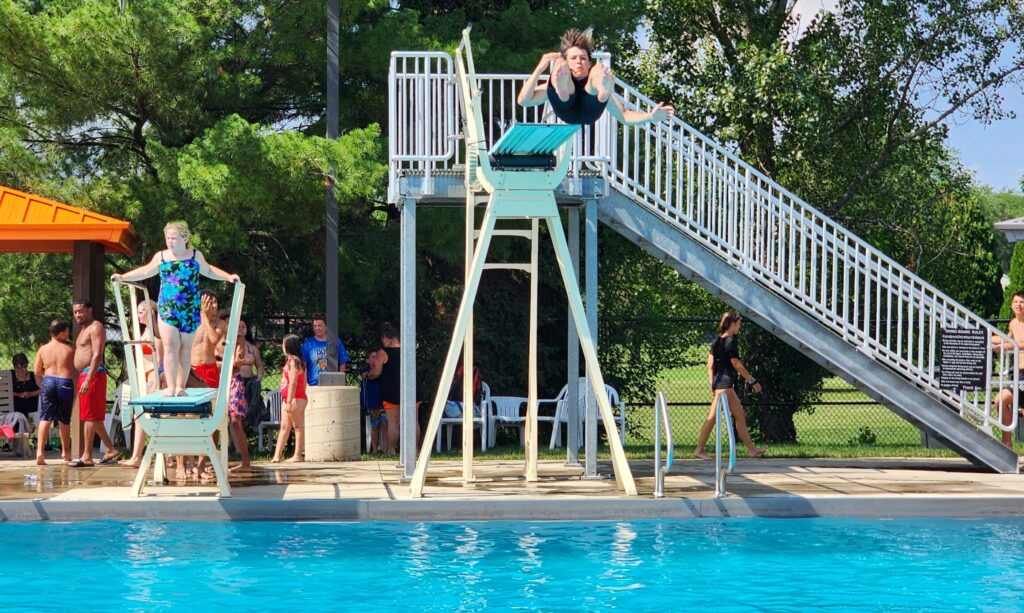
Sweaty day at the pool
Morning classes wrapped up and made way for open swimming at noon. By the middle of Wednesday afternoon, the temperature reached a steamy 93. The pool was full of regulars who spend their summers at the pool, and infrequent patrons who just couldn’t handle the heat at home.
There were a few diehard tanners sweating in the sun, but most adults were crowded under shade structures when they weren’t in the water. While the children splashed around in the pool, adults grabbed innertubes and retreated to the more placid “lazy river.”
Other serious swimmers tried to get in some laps.
The maximum capacity of the pool has been set at 750. When it reaches that number, pool patrons are turned away at the door.
“When we’re full, it is very stressful,” said Josh Chatfield, fitness and aquatic manager for Bowling Green Parks and Recreation Department. “Then again, I hate turning people away.”
On sweltering days, the packed pool water can get pretty cloudy, due to the combination of sweat, dirt, dander and sunscreen, Chatfield explained.

Ten minute breaks are called at the top of every hour to provide the lifeguards with a little relief. On really hot days, the breaks are sometimes stretched an additional five minutes.
By midday on Wednesday, there were an estimated 400 people at the pool. Little children were being watched by parents, pre-teen boys and girls were hanging out in small groups, and older teens were holding unofficial contests for the best dives off the boards, or the biggest splashes from “can-openers” or “cannon balls.”
Among the regulars at the pool was Joyce Langley, of Bowling Green, and her four grandchildren, ages 7 to 11.
“We love it,” Langley said, estimating she and her grandkids retreat from the heat four to five times a week at the pool. If they weren’t swimming, the kids would likely be at home using squirt guns and quibbling, she said.
“It keeps them all busy, so they aren’t arguing,” their grandma said.
Over by the diving boards, Amanda Ward, of Bowling Green, and her children were cheering on her husband as he stepped up on one of the boards. They yelled for a backflip, or a can-opener – and cheered when the splash shot high into the air.
Ward said she and the three kids come to the pool two to three times a week. The older children love the spiral slide and the boards, while the 4-year-old was disappointed again this year that he still wasn’t tall enough to go down the twisty slide.
The pool is a refuge on the hottest days, Ward said.
“Otherwise, we’d be stuck in the house, miserable,” she said. “The heat is disgusting.”

The pool has 73 employees, with 25 or so being lifeguards. The others check in pool patrons and perform cleaning duties.
Inside the lifeguard breakroom, guards cool down and revive themselves with food and fluids.
“It can get pretty hectic,” said Hannah Mathey, who has worked at the pool for three summers and has taken on a leadership role.
On busy days, it’s especially important that the lifeguards stay alert and aware of every person in the pool. As she took her break, Sophia Nelson told of making a save earlier in the day. A “save” is when the guards jump in to assist someone in deeper water than they are able to handle on their own.
Nelson said the child she jumped in for was 6 or 7 years old. And “oh yeah,” there’s nothing like rescuing a swimmer to get the adrenaline going, she said.
The job can be stressful at times, but most of the lifeguards come back for multiple summers.
“I really enjoy it,” Kennedy Keefe said. “I like watching people, making sure they are safe.”
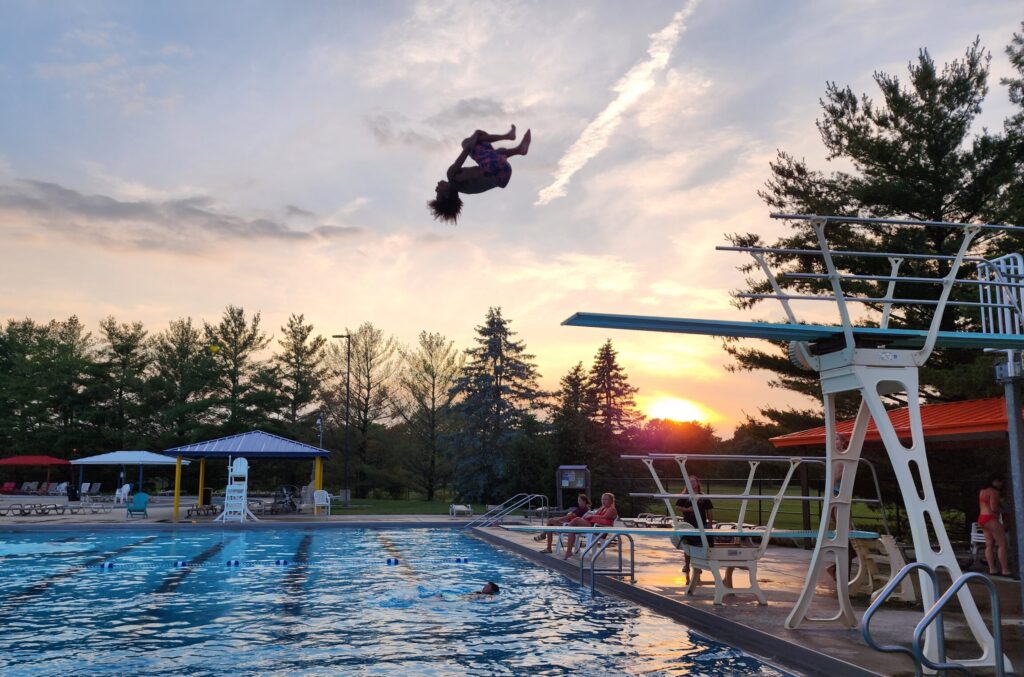
End of a long, hot day
As closing time nears, the pool attendants prepare for their work maintaining the facility. They clean the restrooms and spray down the concessions area, while lifeguards pick up the trash around the pool and sweep out their breakroom.
Young swimmers, who see the pool as their second home in the summer, watch the clock as it ticks closer to 8:45 p.m. – when the final whistle will be blown.
The teens on the diving boards try to squeeze in their last daring flips of the day.
An estimated 600 people came to the pool throughout the day, to make the heat more bearable.
Lifeguard Marissa Holman gets through hot days like Wednesday by bringing in Goldfish crackers, Doritos and her water bottle. “I pack snacks,” she said.
“It was really hot today,” said the first-year lifeguard, who said she plans to return next year.
“It got a little bit crazy, but everyone handled things well,” Mathey said.
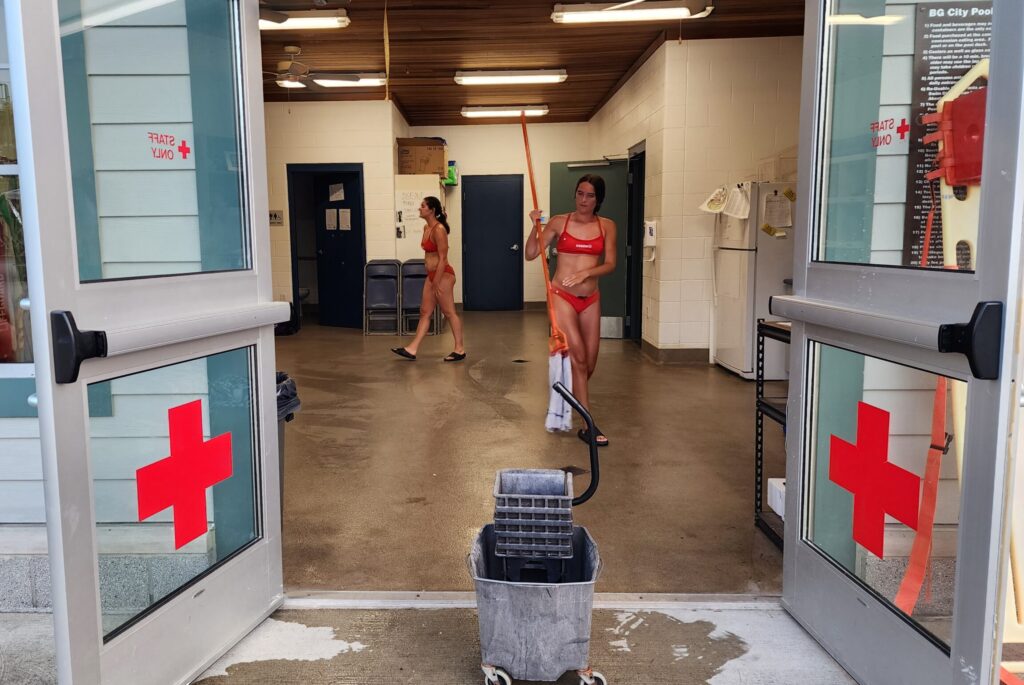
Staffing success
Bowling Green Parks and Recreation Director Kristin Otley often hears of community pools cutting their hours short, or not opening at all.
“We have staff – and that is really saying something,” Otley said during a parks and recreation board meeting. “We’re really, really lucky.”
But Otley quickly corrected herself. It’s not luck that the city pool has adequate staff every year.
She credits Chatfield for his leadership and training at the pool. For many of the lifeguards and swim instructors, working at the pool is their first job. And many of those young employees continue to come back every summer well into their college years.
While other cities have had to cut hours or pay exorbitant wages for lifeguards, Bowling Green pool is able to retain staff for many years in a row, offering training and leadership opportunities.
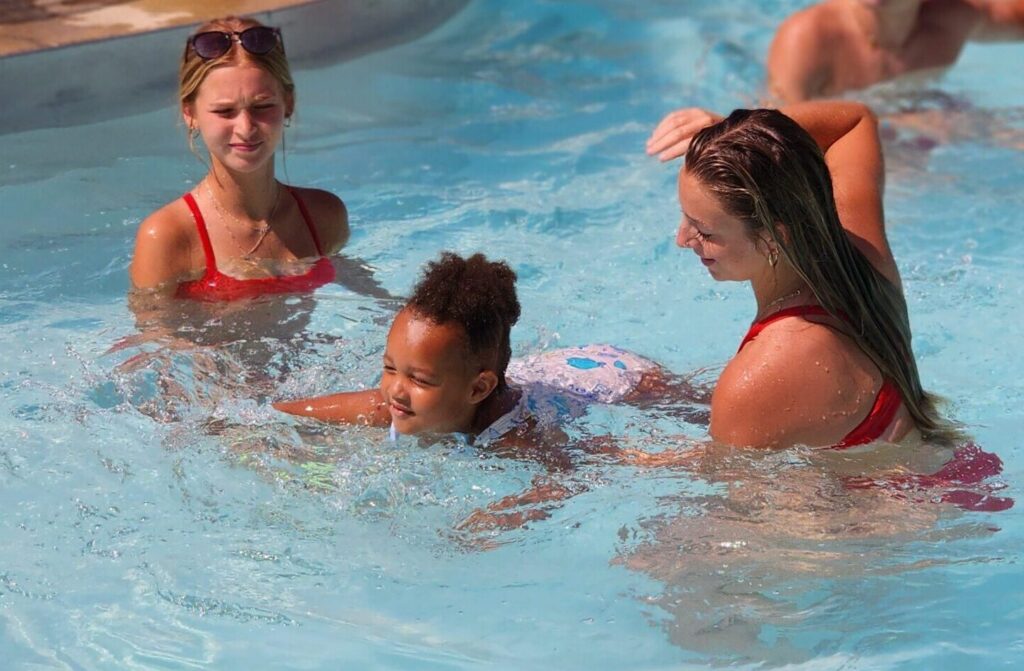
Preventing poo in the pool
The board voted earlier this year to require all children who aren’t potty trained to wear reusable swim pants instead of disposable swim diapers. The reusable swim pants are provided to families at no charge.
“Parents have been really receptive,” Chatfield said last week.
Disposable swim diapers have been required in the past, but they tend to fill up with water as soon as children enter the pool – leaving no room for leaks from young swimmers.
“Poop escapes the diapers – up the back,” Chatfield said.
The Bowling Green Community Foundation provided a $2,440 grant to purchase about 1,000 of the swim pants. The cost of the poop-trapping pants is far less than the cost of treating feces that reaches the pool water.
Treating escaped excrement varies per incident, and can take as long as 24 hours to complete. The costs for the chemicals, staff time for clean up, and lost revenue due to closure range from $750 to $3,625 per fecal incident.
The Bowling Green pool used to experience an average of six stools in the pool each summer. In addition to being costly to resolve, feces in the water is a public health issue. Waterborne illnesses can spread quickly if the waste goes unnoticed or unreported.
Then there is the undeniably undesirable image associated with swimming in water contaminated by fecal matter.
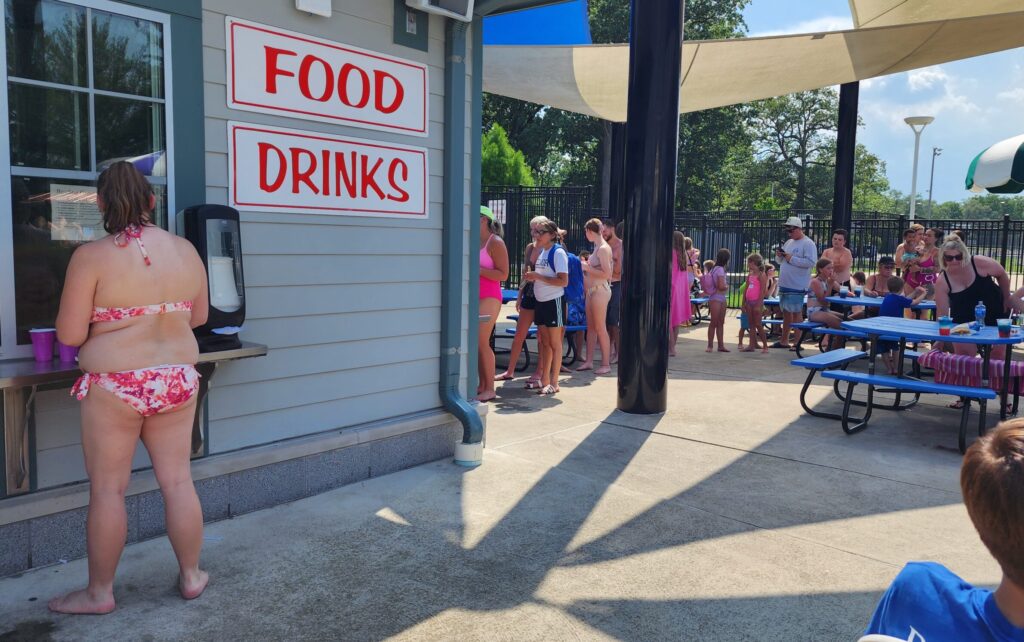
Costs of operating pool
The parks and recreation board voted this spring to increase the price of daily swim passes by 50 cents for non-residents of Bowling Green. City Council agreed.
Last November, Otley informed the board that while swimmers swarmed the pool last summer, revenues took a plunge due to increased costs to operate the site. Any revenue growth from the jump in attendance was eaten up by increased expenses for staff, chemicals, concessions and natural gas.
So when it was all tallied at the close of the season, the pool budget ended up $29,230 in the red – with $326,085 in revenue and $355,315 in expenses. The city had already dedicated $20,000 in American Rescue Plan funding to the pool, so that brought the expenses to $9,230 over budget.
Otley suggested that the daily fee for non-residents be increased 50 cents. That would bring in an estimated $6,000 more this summer. She recommended that rates for city residents remain unchanged, since residents already pay toward the pool through taxes.
The last rate increase at the pool occurred in 2019 – again just for non-residents.
“Non-residents are absolutely welcome to come, but they should pay more,” Otley said.
The numbers presented for the pool in November weren’t all negative. On the bright side, the daily pool admissions were high – bringing in $136,235, nearly $20,000 more than the previous year. Season passes, however, took a dip – totaling $95,068, nearly $12,000 less than the previous year.
Concession sales were high – coming in at $69,539, about $6,000 more than in 2021.
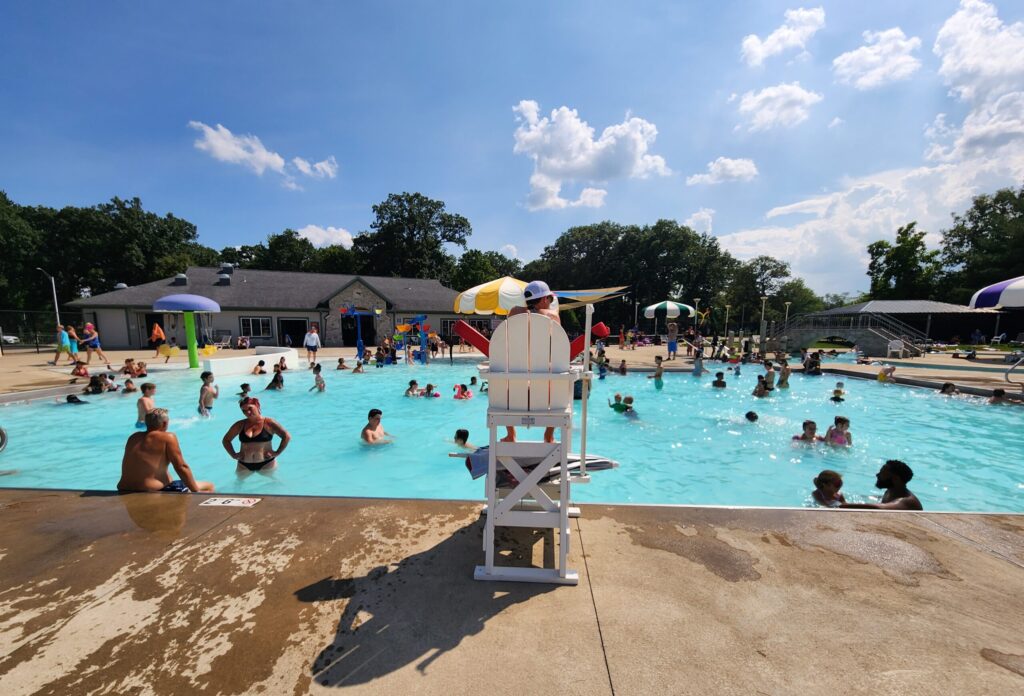
And swimming lessons were solid, with revenue of $25,243, about $900 less than the previous year, despite the decision to drop the maximum class size from 18 to 12 to provide for better instruction and more individual attention for students.
Overall, the revenues were up about 3.6%. However, the expenses for supplies, staffing and deliveries shot up about 7.7%, or $25,552 more than the previous year.
Those expenses included administration and maintenance staff up about $2,000, aquatic staff up around $5,000, chemicals increased by $4,000, concession supplies by nearly $3,000, operating expenses by $9,000, and natural gas by more than $3,000.

